Comprehensive Analysis of Today's White-Collar Crime Report
VerifiedAdded on 2023/04/22
|10
|3328
|94
Report
AI Summary
This report provides a detailed overview of white-collar crime, encompassing various aspects such as crime theories, organizational crime, and corporate criminal liabilities. It delves into historical perspectives, positivist theories like social strain and differential association, and feminist theories in white-collar crime. The report also analyzes organizational structure, environmental factors influencing crime, and steps to reduce it, including examples of corporate crime and fraud. Furthermore, it explores common white-collar crimes like mail fraud, wire fraud, embezzlement, and money laundering, along with asset forfeiture. The analysis extends to intelligence analysts, tactical and strategic intelligence, and trends in white-collar crime, offering a comprehensive understanding of the subject. The report also includes an analysis of the future of white-collar crime.
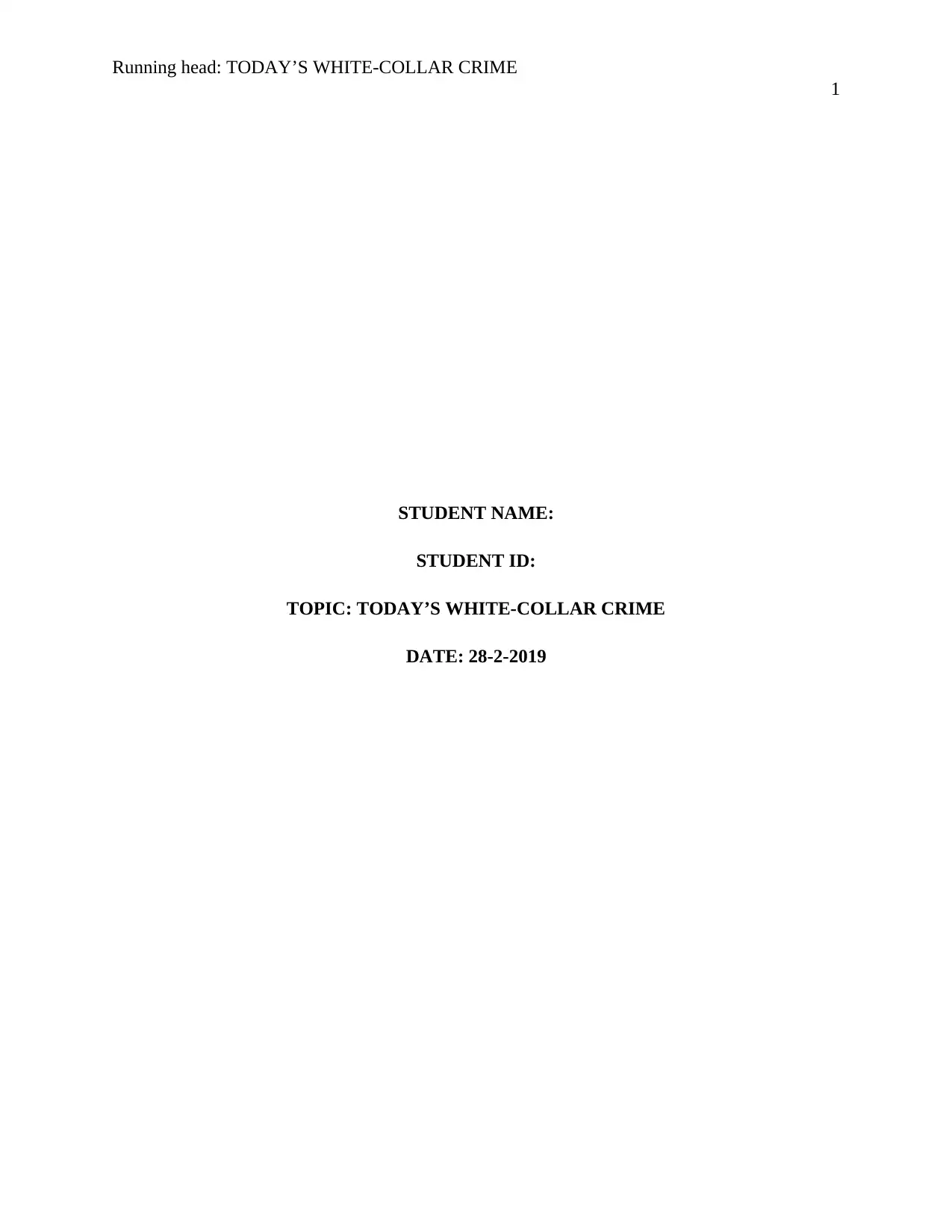
Running head: TODAY’S WHITE-COLLAR CRIME
1
STUDENT NAME:
STUDENT ID:
TOPIC: TODAY’S WHITE-COLLAR CRIME
DATE: 28-2-2019
1
STUDENT NAME:
STUDENT ID:
TOPIC: TODAY’S WHITE-COLLAR CRIME
DATE: 28-2-2019
Secure Best Marks with AI Grader
Need help grading? Try our AI Grader for instant feedback on your assignments.
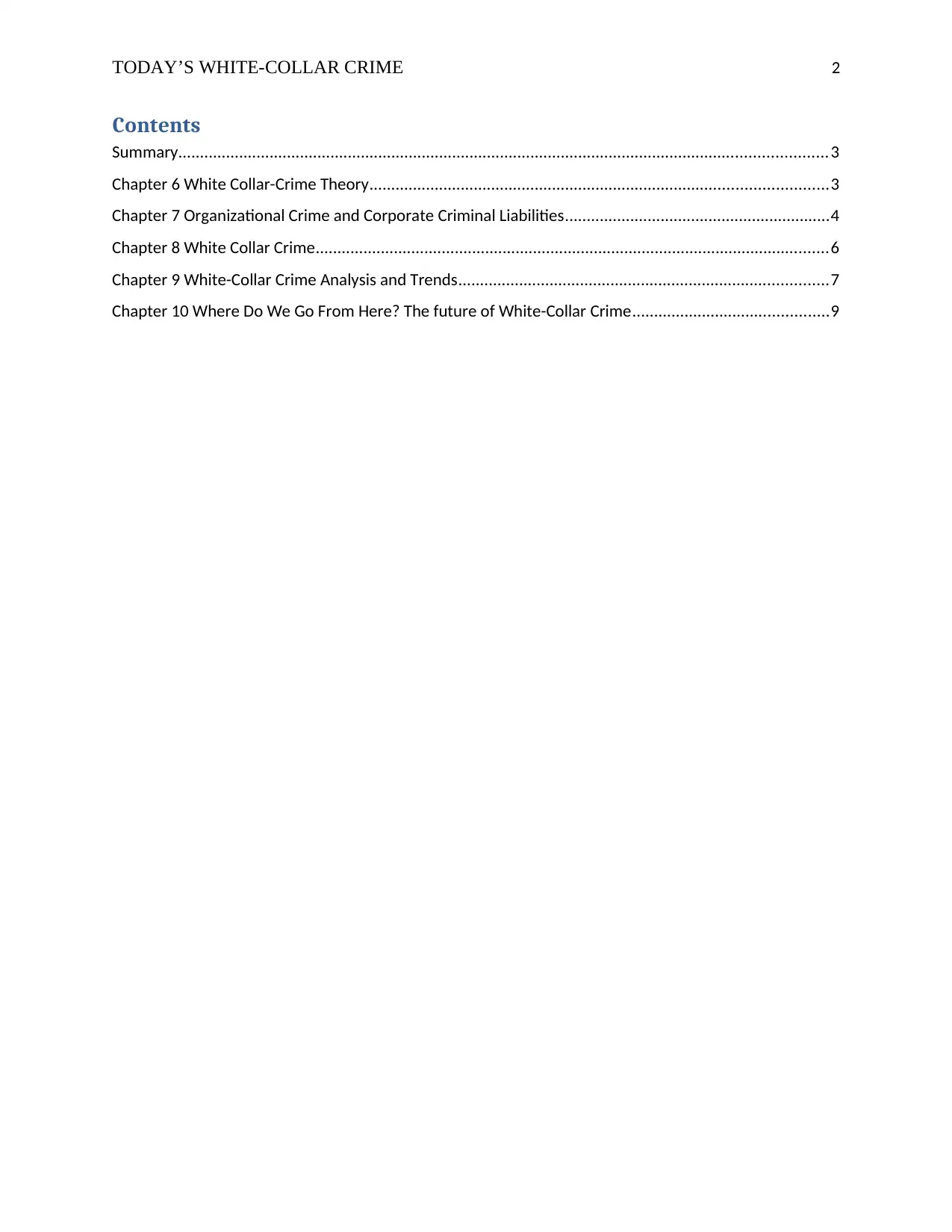
TODAY’S WHITE-COLLAR CRIME 2
Contents
Summary.....................................................................................................................................................3
Chapter 6 White Collar-Crime Theory.........................................................................................................3
Chapter 7 Organizational Crime and Corporate Criminal Liabilities.............................................................4
Chapter 8 White Collar Crime......................................................................................................................6
Chapter 9 White-Collar Crime Analysis and Trends.....................................................................................7
Chapter 10 Where Do We Go From Here? The future of White-Collar Crime.............................................9
Contents
Summary.....................................................................................................................................................3
Chapter 6 White Collar-Crime Theory.........................................................................................................3
Chapter 7 Organizational Crime and Corporate Criminal Liabilities.............................................................4
Chapter 8 White Collar Crime......................................................................................................................6
Chapter 9 White-Collar Crime Analysis and Trends.....................................................................................7
Chapter 10 Where Do We Go From Here? The future of White-Collar Crime.............................................9
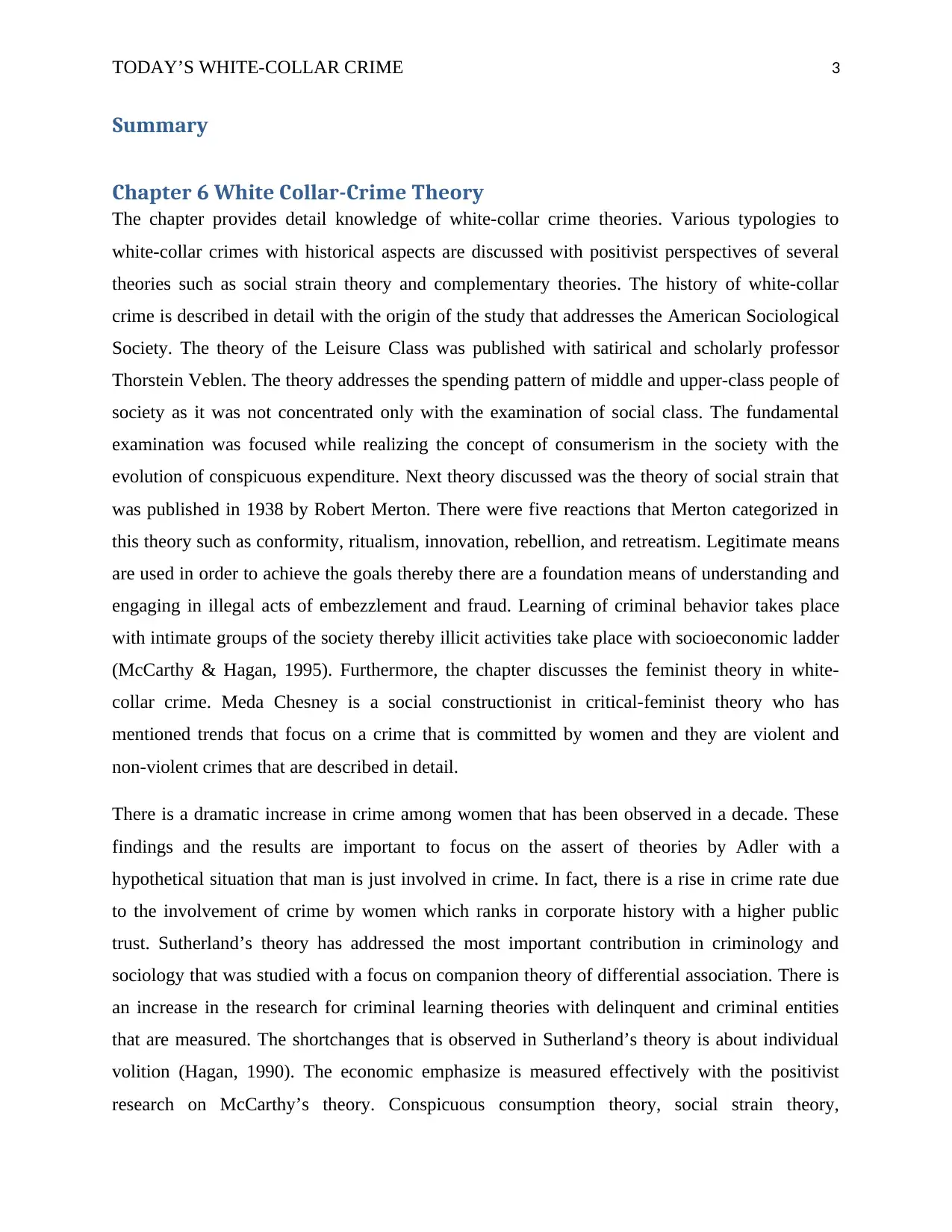
TODAY’S WHITE-COLLAR CRIME 3
Summary
Chapter 6 White Collar-Crime Theory
The chapter provides detail knowledge of white-collar crime theories. Various typologies to
white-collar crimes with historical aspects are discussed with positivist perspectives of several
theories such as social strain theory and complementary theories. The history of white-collar
crime is described in detail with the origin of the study that addresses the American Sociological
Society. The theory of the Leisure Class was published with satirical and scholarly professor
Thorstein Veblen. The theory addresses the spending pattern of middle and upper-class people of
society as it was not concentrated only with the examination of social class. The fundamental
examination was focused while realizing the concept of consumerism in the society with the
evolution of conspicuous expenditure. Next theory discussed was the theory of social strain that
was published in 1938 by Robert Merton. There were five reactions that Merton categorized in
this theory such as conformity, ritualism, innovation, rebellion, and retreatism. Legitimate means
are used in order to achieve the goals thereby there are a foundation means of understanding and
engaging in illegal acts of embezzlement and fraud. Learning of criminal behavior takes place
with intimate groups of the society thereby illicit activities take place with socioeconomic ladder
(McCarthy & Hagan, 1995). Furthermore, the chapter discusses the feminist theory in white-
collar crime. Meda Chesney is a social constructionist in critical-feminist theory who has
mentioned trends that focus on a crime that is committed by women and they are violent and
non-violent crimes that are described in detail.
There is a dramatic increase in crime among women that has been observed in a decade. These
findings and the results are important to focus on the assert of theories by Adler with a
hypothetical situation that man is just involved in crime. In fact, there is a rise in crime rate due
to the involvement of crime by women which ranks in corporate history with a higher public
trust. Sutherland’s theory has addressed the most important contribution in criminology and
sociology that was studied with a focus on companion theory of differential association. There is
an increase in the research for criminal learning theories with delinquent and criminal entities
that are measured. The shortchanges that is observed in Sutherland’s theory is about individual
volition (Hagan, 1990). The economic emphasize is measured effectively with the positivist
research on McCarthy’s theory. Conspicuous consumption theory, social strain theory,
Summary
Chapter 6 White Collar-Crime Theory
The chapter provides detail knowledge of white-collar crime theories. Various typologies to
white-collar crimes with historical aspects are discussed with positivist perspectives of several
theories such as social strain theory and complementary theories. The history of white-collar
crime is described in detail with the origin of the study that addresses the American Sociological
Society. The theory of the Leisure Class was published with satirical and scholarly professor
Thorstein Veblen. The theory addresses the spending pattern of middle and upper-class people of
society as it was not concentrated only with the examination of social class. The fundamental
examination was focused while realizing the concept of consumerism in the society with the
evolution of conspicuous expenditure. Next theory discussed was the theory of social strain that
was published in 1938 by Robert Merton. There were five reactions that Merton categorized in
this theory such as conformity, ritualism, innovation, rebellion, and retreatism. Legitimate means
are used in order to achieve the goals thereby there are a foundation means of understanding and
engaging in illegal acts of embezzlement and fraud. Learning of criminal behavior takes place
with intimate groups of the society thereby illicit activities take place with socioeconomic ladder
(McCarthy & Hagan, 1995). Furthermore, the chapter discusses the feminist theory in white-
collar crime. Meda Chesney is a social constructionist in critical-feminist theory who has
mentioned trends that focus on a crime that is committed by women and they are violent and
non-violent crimes that are described in detail.
There is a dramatic increase in crime among women that has been observed in a decade. These
findings and the results are important to focus on the assert of theories by Adler with a
hypothetical situation that man is just involved in crime. In fact, there is a rise in crime rate due
to the involvement of crime by women which ranks in corporate history with a higher public
trust. Sutherland’s theory has addressed the most important contribution in criminology and
sociology that was studied with a focus on companion theory of differential association. There is
an increase in the research for criminal learning theories with delinquent and criminal entities
that are measured. The shortchanges that is observed in Sutherland’s theory is about individual
volition (Hagan, 1990). The economic emphasize is measured effectively with the positivist
research on McCarthy’s theory. Conspicuous consumption theory, social strain theory,
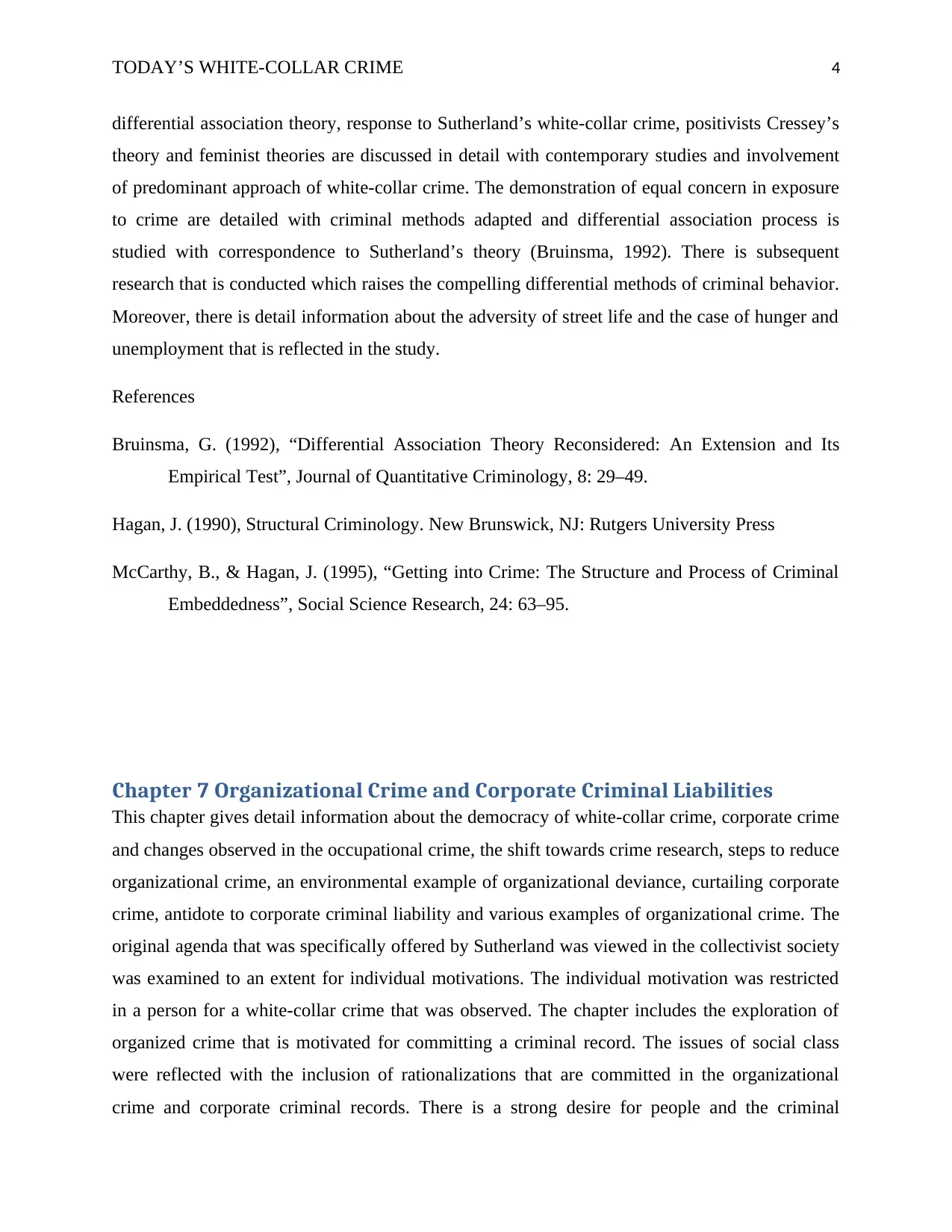
TODAY’S WHITE-COLLAR CRIME 4
differential association theory, response to Sutherland’s white-collar crime, positivists Cressey’s
theory and feminist theories are discussed in detail with contemporary studies and involvement
of predominant approach of white-collar crime. The demonstration of equal concern in exposure
to crime are detailed with criminal methods adapted and differential association process is
studied with correspondence to Sutherland’s theory (Bruinsma, 1992). There is subsequent
research that is conducted which raises the compelling differential methods of criminal behavior.
Moreover, there is detail information about the adversity of street life and the case of hunger and
unemployment that is reflected in the study.
References
Bruinsma, G. (1992), “Differential Association Theory Reconsidered: An Extension and Its
Empirical Test”, Journal of Quantitative Criminology, 8: 29–49.
Hagan, J. (1990), Structural Criminology. New Brunswick, NJ: Rutgers University Press
McCarthy, B., & Hagan, J. (1995), “Getting into Crime: The Structure and Process of Criminal
Embeddedness”, Social Science Research, 24: 63–95.
Chapter 7 Organizational Crime and Corporate Criminal Liabilities
This chapter gives detail information about the democracy of white-collar crime, corporate crime
and changes observed in the occupational crime, the shift towards crime research, steps to reduce
organizational crime, an environmental example of organizational deviance, curtailing corporate
crime, antidote to corporate criminal liability and various examples of organizational crime. The
original agenda that was specifically offered by Sutherland was viewed in the collectivist society
was examined to an extent for individual motivations. The individual motivation was restricted
in a person for a white-collar crime that was observed. The chapter includes the exploration of
organized crime that is motivated for committing a criminal record. The issues of social class
were reflected with the inclusion of rationalizations that are committed in the organizational
crime and corporate criminal records. There is a strong desire for people and the criminal
differential association theory, response to Sutherland’s white-collar crime, positivists Cressey’s
theory and feminist theories are discussed in detail with contemporary studies and involvement
of predominant approach of white-collar crime. The demonstration of equal concern in exposure
to crime are detailed with criminal methods adapted and differential association process is
studied with correspondence to Sutherland’s theory (Bruinsma, 1992). There is subsequent
research that is conducted which raises the compelling differential methods of criminal behavior.
Moreover, there is detail information about the adversity of street life and the case of hunger and
unemployment that is reflected in the study.
References
Bruinsma, G. (1992), “Differential Association Theory Reconsidered: An Extension and Its
Empirical Test”, Journal of Quantitative Criminology, 8: 29–49.
Hagan, J. (1990), Structural Criminology. New Brunswick, NJ: Rutgers University Press
McCarthy, B., & Hagan, J. (1995), “Getting into Crime: The Structure and Process of Criminal
Embeddedness”, Social Science Research, 24: 63–95.
Chapter 7 Organizational Crime and Corporate Criminal Liabilities
This chapter gives detail information about the democracy of white-collar crime, corporate crime
and changes observed in the occupational crime, the shift towards crime research, steps to reduce
organizational crime, an environmental example of organizational deviance, curtailing corporate
crime, antidote to corporate criminal liability and various examples of organizational crime. The
original agenda that was specifically offered by Sutherland was viewed in the collectivist society
was examined to an extent for individual motivations. The individual motivation was restricted
in a person for a white-collar crime that was observed. The chapter includes the exploration of
organized crime that is motivated for committing a criminal record. The issues of social class
were reflected with the inclusion of rationalizations that are committed in the organizational
crime and corporate criminal records. There is a strong desire for people and the criminal
Secure Best Marks with AI Grader
Need help grading? Try our AI Grader for instant feedback on your assignments.
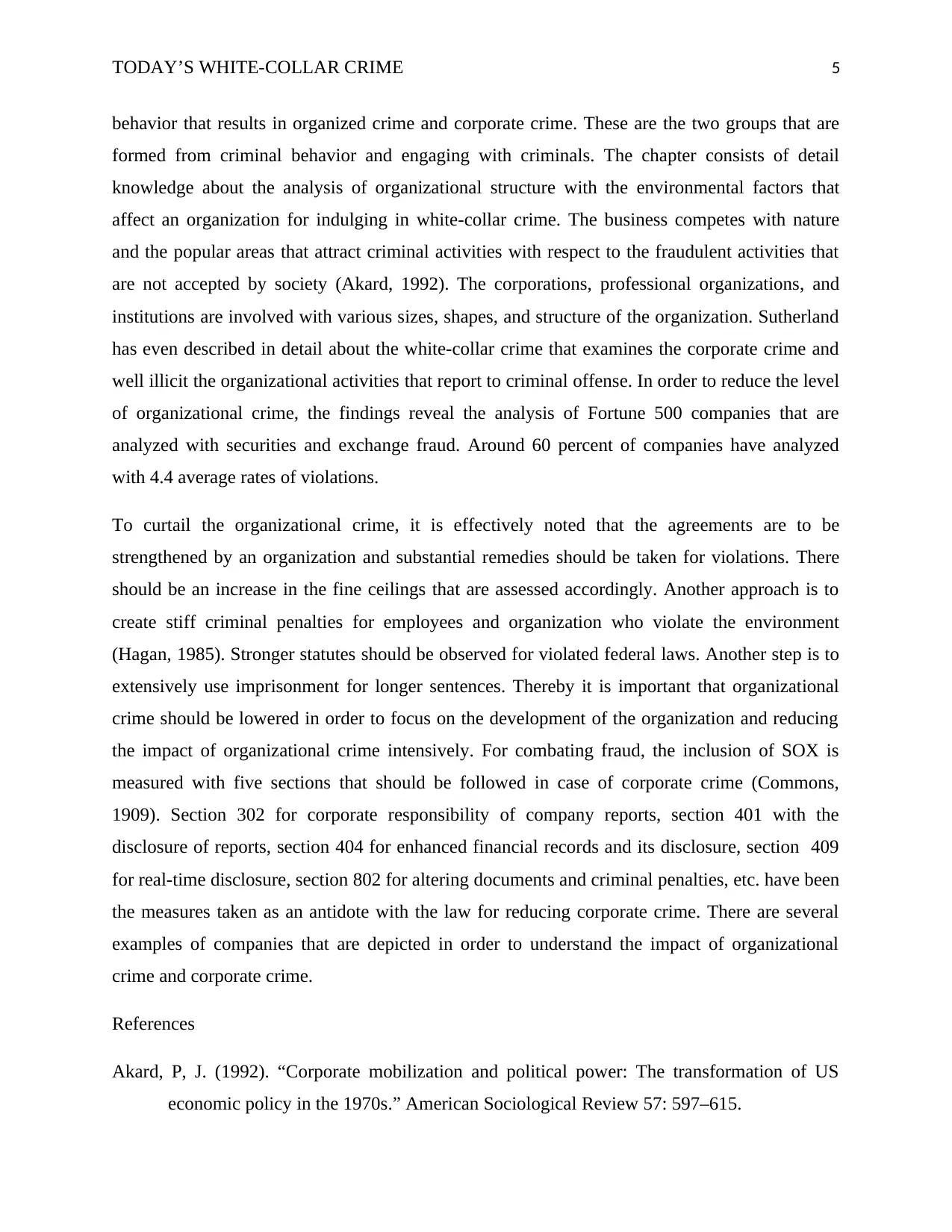
TODAY’S WHITE-COLLAR CRIME 5
behavior that results in organized crime and corporate crime. These are the two groups that are
formed from criminal behavior and engaging with criminals. The chapter consists of detail
knowledge about the analysis of organizational structure with the environmental factors that
affect an organization for indulging in white-collar crime. The business competes with nature
and the popular areas that attract criminal activities with respect to the fraudulent activities that
are not accepted by society (Akard, 1992). The corporations, professional organizations, and
institutions are involved with various sizes, shapes, and structure of the organization. Sutherland
has even described in detail about the white-collar crime that examines the corporate crime and
well illicit the organizational activities that report to criminal offense. In order to reduce the level
of organizational crime, the findings reveal the analysis of Fortune 500 companies that are
analyzed with securities and exchange fraud. Around 60 percent of companies have analyzed
with 4.4 average rates of violations.
To curtail the organizational crime, it is effectively noted that the agreements are to be
strengthened by an organization and substantial remedies should be taken for violations. There
should be an increase in the fine ceilings that are assessed accordingly. Another approach is to
create stiff criminal penalties for employees and organization who violate the environment
(Hagan, 1985). Stronger statutes should be observed for violated federal laws. Another step is to
extensively use imprisonment for longer sentences. Thereby it is important that organizational
crime should be lowered in order to focus on the development of the organization and reducing
the impact of organizational crime intensively. For combating fraud, the inclusion of SOX is
measured with five sections that should be followed in case of corporate crime (Commons,
1909). Section 302 for corporate responsibility of company reports, section 401 with the
disclosure of reports, section 404 for enhanced financial records and its disclosure, section 409
for real-time disclosure, section 802 for altering documents and criminal penalties, etc. have been
the measures taken as an antidote with the law for reducing corporate crime. There are several
examples of companies that are depicted in order to understand the impact of organizational
crime and corporate crime.
References
Akard, P, J. (1992). “Corporate mobilization and political power: The transformation of US
economic policy in the 1970s.” American Sociological Review 57: 597–615.
behavior that results in organized crime and corporate crime. These are the two groups that are
formed from criminal behavior and engaging with criminals. The chapter consists of detail
knowledge about the analysis of organizational structure with the environmental factors that
affect an organization for indulging in white-collar crime. The business competes with nature
and the popular areas that attract criminal activities with respect to the fraudulent activities that
are not accepted by society (Akard, 1992). The corporations, professional organizations, and
institutions are involved with various sizes, shapes, and structure of the organization. Sutherland
has even described in detail about the white-collar crime that examines the corporate crime and
well illicit the organizational activities that report to criminal offense. In order to reduce the level
of organizational crime, the findings reveal the analysis of Fortune 500 companies that are
analyzed with securities and exchange fraud. Around 60 percent of companies have analyzed
with 4.4 average rates of violations.
To curtail the organizational crime, it is effectively noted that the agreements are to be
strengthened by an organization and substantial remedies should be taken for violations. There
should be an increase in the fine ceilings that are assessed accordingly. Another approach is to
create stiff criminal penalties for employees and organization who violate the environment
(Hagan, 1985). Stronger statutes should be observed for violated federal laws. Another step is to
extensively use imprisonment for longer sentences. Thereby it is important that organizational
crime should be lowered in order to focus on the development of the organization and reducing
the impact of organizational crime intensively. For combating fraud, the inclusion of SOX is
measured with five sections that should be followed in case of corporate crime (Commons,
1909). Section 302 for corporate responsibility of company reports, section 401 with the
disclosure of reports, section 404 for enhanced financial records and its disclosure, section 409
for real-time disclosure, section 802 for altering documents and criminal penalties, etc. have been
the measures taken as an antidote with the law for reducing corporate crime. There are several
examples of companies that are depicted in order to understand the impact of organizational
crime and corporate crime.
References
Akard, P, J. (1992). “Corporate mobilization and political power: The transformation of US
economic policy in the 1970s.” American Sociological Review 57: 597–615.
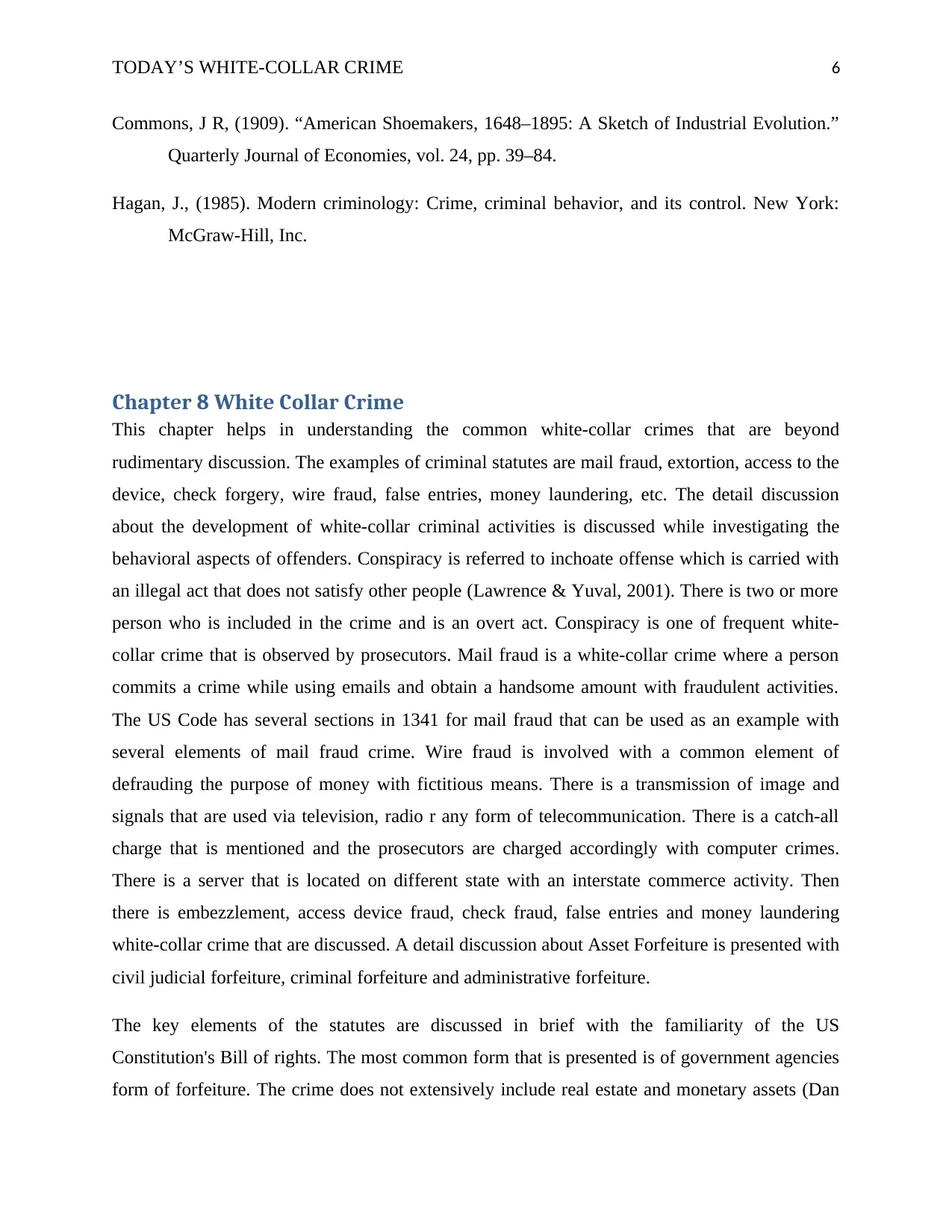
TODAY’S WHITE-COLLAR CRIME 6
Commons, J R, (1909). “American Shoemakers, 1648–1895: A Sketch of Industrial Evolution.”
Quarterly Journal of Economies, vol. 24, pp. 39–84.
Hagan, J., (1985). Modern criminology: Crime, criminal behavior, and its control. New York:
McGraw-Hill, Inc.
Chapter 8 White Collar Crime
This chapter helps in understanding the common white-collar crimes that are beyond
rudimentary discussion. The examples of criminal statutes are mail fraud, extortion, access to the
device, check forgery, wire fraud, false entries, money laundering, etc. The detail discussion
about the development of white-collar criminal activities is discussed while investigating the
behavioral aspects of offenders. Conspiracy is referred to inchoate offense which is carried with
an illegal act that does not satisfy other people (Lawrence & Yuval, 2001). There is two or more
person who is included in the crime and is an overt act. Conspiracy is one of frequent white-
collar crime that is observed by prosecutors. Mail fraud is a white-collar crime where a person
commits a crime while using emails and obtain a handsome amount with fraudulent activities.
The US Code has several sections in 1341 for mail fraud that can be used as an example with
several elements of mail fraud crime. Wire fraud is involved with a common element of
defrauding the purpose of money with fictitious means. There is a transmission of image and
signals that are used via television, radio r any form of telecommunication. There is a catch-all
charge that is mentioned and the prosecutors are charged accordingly with computer crimes.
There is a server that is located on different state with an interstate commerce activity. Then
there is embezzlement, access device fraud, check fraud, false entries and money laundering
white-collar crime that are discussed. A detail discussion about Asset Forfeiture is presented with
civil judicial forfeiture, criminal forfeiture and administrative forfeiture.
The key elements of the statutes are discussed in brief with the familiarity of the US
Constitution's Bill of rights. The most common form that is presented is of government agencies
form of forfeiture. The crime does not extensively include real estate and monetary assets (Dan
Commons, J R, (1909). “American Shoemakers, 1648–1895: A Sketch of Industrial Evolution.”
Quarterly Journal of Economies, vol. 24, pp. 39–84.
Hagan, J., (1985). Modern criminology: Crime, criminal behavior, and its control. New York:
McGraw-Hill, Inc.
Chapter 8 White Collar Crime
This chapter helps in understanding the common white-collar crimes that are beyond
rudimentary discussion. The examples of criminal statutes are mail fraud, extortion, access to the
device, check forgery, wire fraud, false entries, money laundering, etc. The detail discussion
about the development of white-collar criminal activities is discussed while investigating the
behavioral aspects of offenders. Conspiracy is referred to inchoate offense which is carried with
an illegal act that does not satisfy other people (Lawrence & Yuval, 2001). There is two or more
person who is included in the crime and is an overt act. Conspiracy is one of frequent white-
collar crime that is observed by prosecutors. Mail fraud is a white-collar crime where a person
commits a crime while using emails and obtain a handsome amount with fraudulent activities.
The US Code has several sections in 1341 for mail fraud that can be used as an example with
several elements of mail fraud crime. Wire fraud is involved with a common element of
defrauding the purpose of money with fictitious means. There is a transmission of image and
signals that are used via television, radio r any form of telecommunication. There is a catch-all
charge that is mentioned and the prosecutors are charged accordingly with computer crimes.
There is a server that is located on different state with an interstate commerce activity. Then
there is embezzlement, access device fraud, check fraud, false entries and money laundering
white-collar crime that are discussed. A detail discussion about Asset Forfeiture is presented with
civil judicial forfeiture, criminal forfeiture and administrative forfeiture.
The key elements of the statutes are discussed in brief with the familiarity of the US
Constitution's Bill of rights. The most common form that is presented is of government agencies
form of forfeiture. The crime does not extensively include real estate and monetary assets (Dan
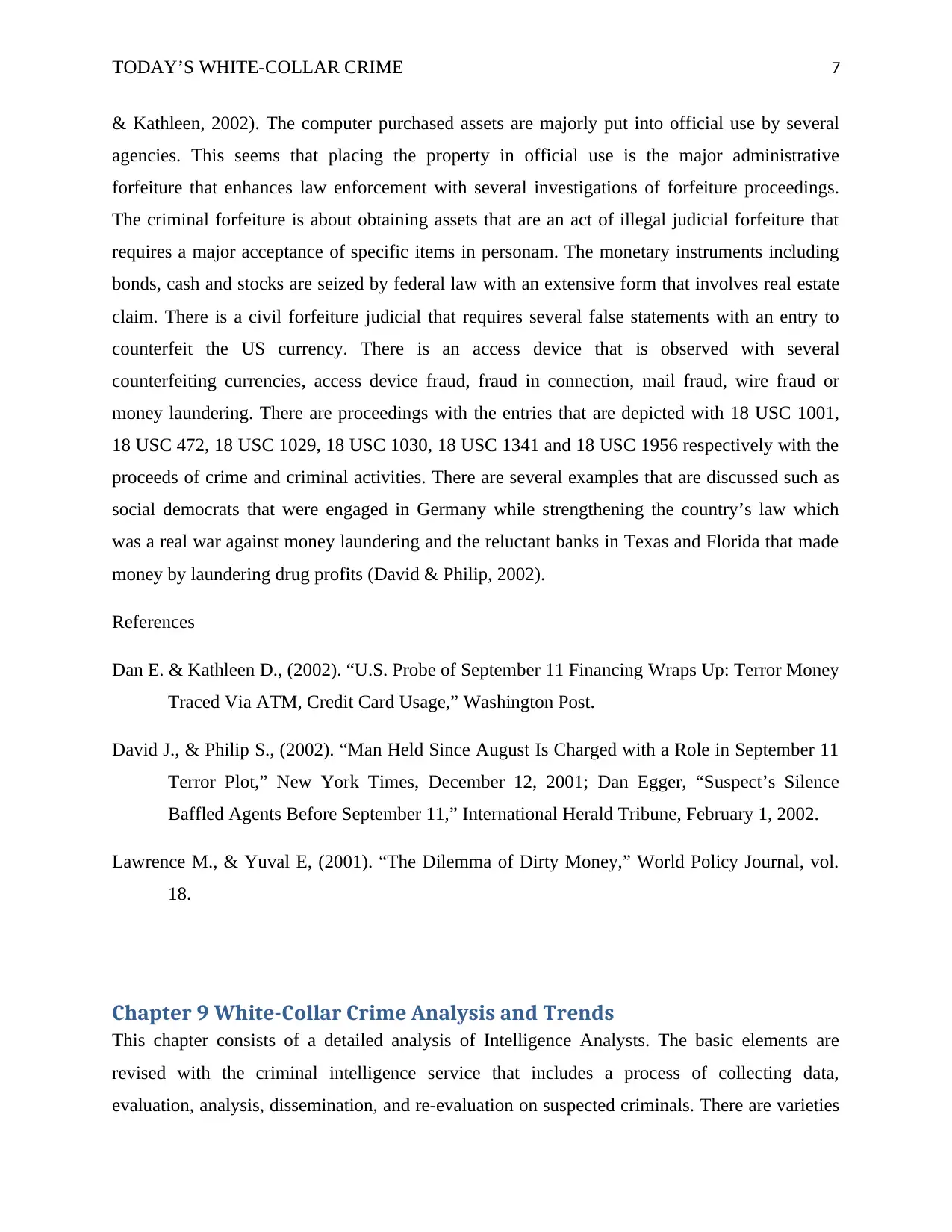
TODAY’S WHITE-COLLAR CRIME 7
& Kathleen, 2002). The computer purchased assets are majorly put into official use by several
agencies. This seems that placing the property in official use is the major administrative
forfeiture that enhances law enforcement with several investigations of forfeiture proceedings.
The criminal forfeiture is about obtaining assets that are an act of illegal judicial forfeiture that
requires a major acceptance of specific items in personam. The monetary instruments including
bonds, cash and stocks are seized by federal law with an extensive form that involves real estate
claim. There is a civil forfeiture judicial that requires several false statements with an entry to
counterfeit the US currency. There is an access device that is observed with several
counterfeiting currencies, access device fraud, fraud in connection, mail fraud, wire fraud or
money laundering. There are proceedings with the entries that are depicted with 18 USC 1001,
18 USC 472, 18 USC 1029, 18 USC 1030, 18 USC 1341 and 18 USC 1956 respectively with the
proceeds of crime and criminal activities. There are several examples that are discussed such as
social democrats that were engaged in Germany while strengthening the country’s law which
was a real war against money laundering and the reluctant banks in Texas and Florida that made
money by laundering drug profits (David & Philip, 2002).
References
Dan E. & Kathleen D., (2002). “U.S. Probe of September 11 Financing Wraps Up: Terror Money
Traced Via ATM, Credit Card Usage,” Washington Post.
David J., & Philip S., (2002). “Man Held Since August Is Charged with a Role in September 11
Terror Plot,” New York Times, December 12, 2001; Dan Egger, “Suspect’s Silence
Baffled Agents Before September 11,” International Herald Tribune, February 1, 2002.
Lawrence M., & Yuval E, (2001). “The Dilemma of Dirty Money,” World Policy Journal, vol.
18.
Chapter 9 White-Collar Crime Analysis and Trends
This chapter consists of a detailed analysis of Intelligence Analysts. The basic elements are
revised with the criminal intelligence service that includes a process of collecting data,
evaluation, analysis, dissemination, and re-evaluation on suspected criminals. There are varieties
& Kathleen, 2002). The computer purchased assets are majorly put into official use by several
agencies. This seems that placing the property in official use is the major administrative
forfeiture that enhances law enforcement with several investigations of forfeiture proceedings.
The criminal forfeiture is about obtaining assets that are an act of illegal judicial forfeiture that
requires a major acceptance of specific items in personam. The monetary instruments including
bonds, cash and stocks are seized by federal law with an extensive form that involves real estate
claim. There is a civil forfeiture judicial that requires several false statements with an entry to
counterfeit the US currency. There is an access device that is observed with several
counterfeiting currencies, access device fraud, fraud in connection, mail fraud, wire fraud or
money laundering. There are proceedings with the entries that are depicted with 18 USC 1001,
18 USC 472, 18 USC 1029, 18 USC 1030, 18 USC 1341 and 18 USC 1956 respectively with the
proceeds of crime and criminal activities. There are several examples that are discussed such as
social democrats that were engaged in Germany while strengthening the country’s law which
was a real war against money laundering and the reluctant banks in Texas and Florida that made
money by laundering drug profits (David & Philip, 2002).
References
Dan E. & Kathleen D., (2002). “U.S. Probe of September 11 Financing Wraps Up: Terror Money
Traced Via ATM, Credit Card Usage,” Washington Post.
David J., & Philip S., (2002). “Man Held Since August Is Charged with a Role in September 11
Terror Plot,” New York Times, December 12, 2001; Dan Egger, “Suspect’s Silence
Baffled Agents Before September 11,” International Herald Tribune, February 1, 2002.
Lawrence M., & Yuval E, (2001). “The Dilemma of Dirty Money,” World Policy Journal, vol.
18.
Chapter 9 White-Collar Crime Analysis and Trends
This chapter consists of a detailed analysis of Intelligence Analysts. The basic elements are
revised with the criminal intelligence service that includes a process of collecting data,
evaluation, analysis, dissemination, and re-evaluation on suspected criminals. There are varieties
Paraphrase This Document
Need a fresh take? Get an instant paraphrase of this document with our AI Paraphraser
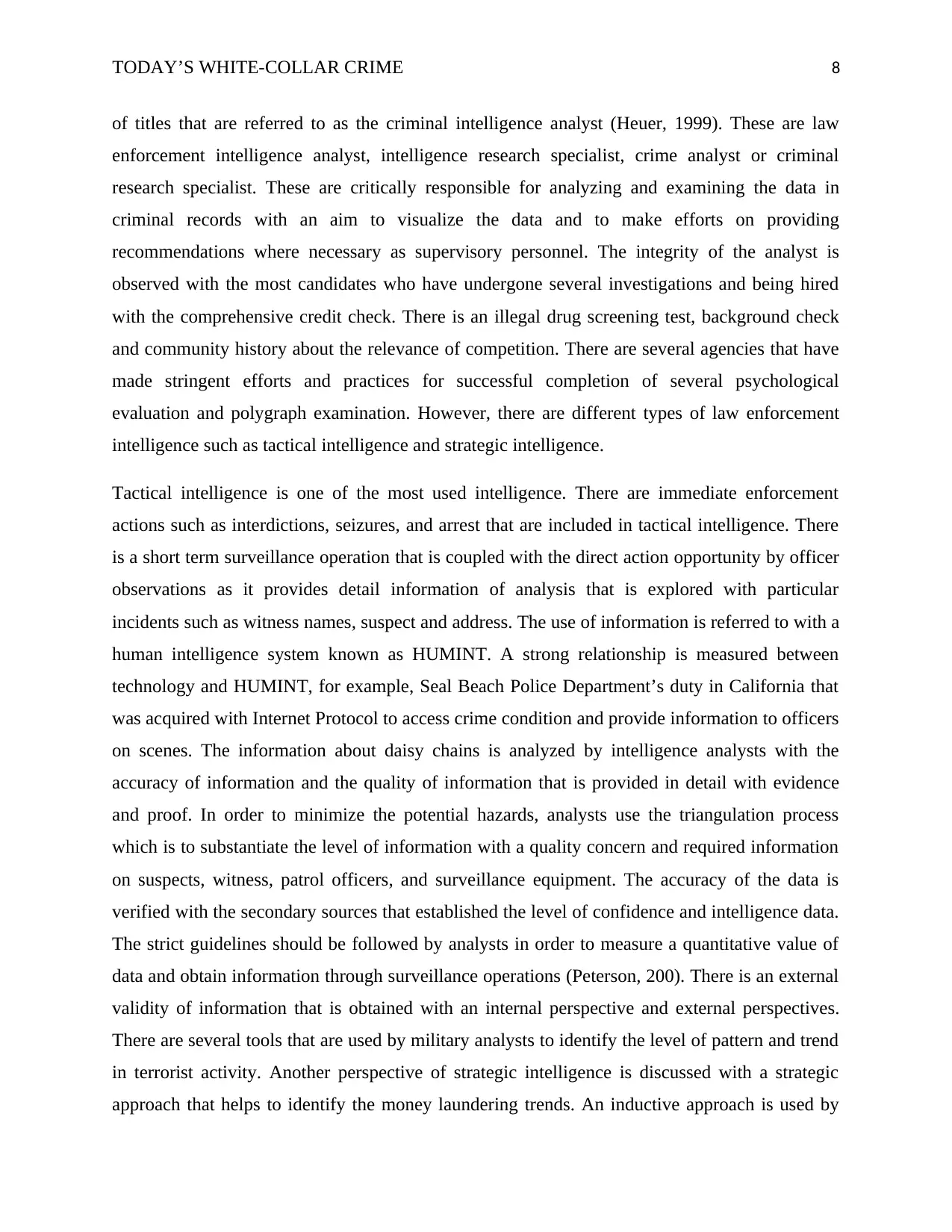
TODAY’S WHITE-COLLAR CRIME 8
of titles that are referred to as the criminal intelligence analyst (Heuer, 1999). These are law
enforcement intelligence analyst, intelligence research specialist, crime analyst or criminal
research specialist. These are critically responsible for analyzing and examining the data in
criminal records with an aim to visualize the data and to make efforts on providing
recommendations where necessary as supervisory personnel. The integrity of the analyst is
observed with the most candidates who have undergone several investigations and being hired
with the comprehensive credit check. There is an illegal drug screening test, background check
and community history about the relevance of competition. There are several agencies that have
made stringent efforts and practices for successful completion of several psychological
evaluation and polygraph examination. However, there are different types of law enforcement
intelligence such as tactical intelligence and strategic intelligence.
Tactical intelligence is one of the most used intelligence. There are immediate enforcement
actions such as interdictions, seizures, and arrest that are included in tactical intelligence. There
is a short term surveillance operation that is coupled with the direct action opportunity by officer
observations as it provides detail information of analysis that is explored with particular
incidents such as witness names, suspect and address. The use of information is referred to with a
human intelligence system known as HUMINT. A strong relationship is measured between
technology and HUMINT, for example, Seal Beach Police Department’s duty in California that
was acquired with Internet Protocol to access crime condition and provide information to officers
on scenes. The information about daisy chains is analyzed by intelligence analysts with the
accuracy of information and the quality of information that is provided in detail with evidence
and proof. In order to minimize the potential hazards, analysts use the triangulation process
which is to substantiate the level of information with a quality concern and required information
on suspects, witness, patrol officers, and surveillance equipment. The accuracy of the data is
verified with the secondary sources that established the level of confidence and intelligence data.
The strict guidelines should be followed by analysts in order to measure a quantitative value of
data and obtain information through surveillance operations (Peterson, 200). There is an external
validity of information that is obtained with an internal perspective and external perspectives.
There are several tools that are used by military analysts to identify the level of pattern and trend
in terrorist activity. Another perspective of strategic intelligence is discussed with a strategic
approach that helps to identify the money laundering trends. An inductive approach is used by
of titles that are referred to as the criminal intelligence analyst (Heuer, 1999). These are law
enforcement intelligence analyst, intelligence research specialist, crime analyst or criminal
research specialist. These are critically responsible for analyzing and examining the data in
criminal records with an aim to visualize the data and to make efforts on providing
recommendations where necessary as supervisory personnel. The integrity of the analyst is
observed with the most candidates who have undergone several investigations and being hired
with the comprehensive credit check. There is an illegal drug screening test, background check
and community history about the relevance of competition. There are several agencies that have
made stringent efforts and practices for successful completion of several psychological
evaluation and polygraph examination. However, there are different types of law enforcement
intelligence such as tactical intelligence and strategic intelligence.
Tactical intelligence is one of the most used intelligence. There are immediate enforcement
actions such as interdictions, seizures, and arrest that are included in tactical intelligence. There
is a short term surveillance operation that is coupled with the direct action opportunity by officer
observations as it provides detail information of analysis that is explored with particular
incidents such as witness names, suspect and address. The use of information is referred to with a
human intelligence system known as HUMINT. A strong relationship is measured between
technology and HUMINT, for example, Seal Beach Police Department’s duty in California that
was acquired with Internet Protocol to access crime condition and provide information to officers
on scenes. The information about daisy chains is analyzed by intelligence analysts with the
accuracy of information and the quality of information that is provided in detail with evidence
and proof. In order to minimize the potential hazards, analysts use the triangulation process
which is to substantiate the level of information with a quality concern and required information
on suspects, witness, patrol officers, and surveillance equipment. The accuracy of the data is
verified with the secondary sources that established the level of confidence and intelligence data.
The strict guidelines should be followed by analysts in order to measure a quantitative value of
data and obtain information through surveillance operations (Peterson, 200). There is an external
validity of information that is obtained with an internal perspective and external perspectives.
There are several tools that are used by military analysts to identify the level of pattern and trend
in terrorist activity. Another perspective of strategic intelligence is discussed with a strategic
approach that helps to identify the money laundering trends. An inductive approach is used by
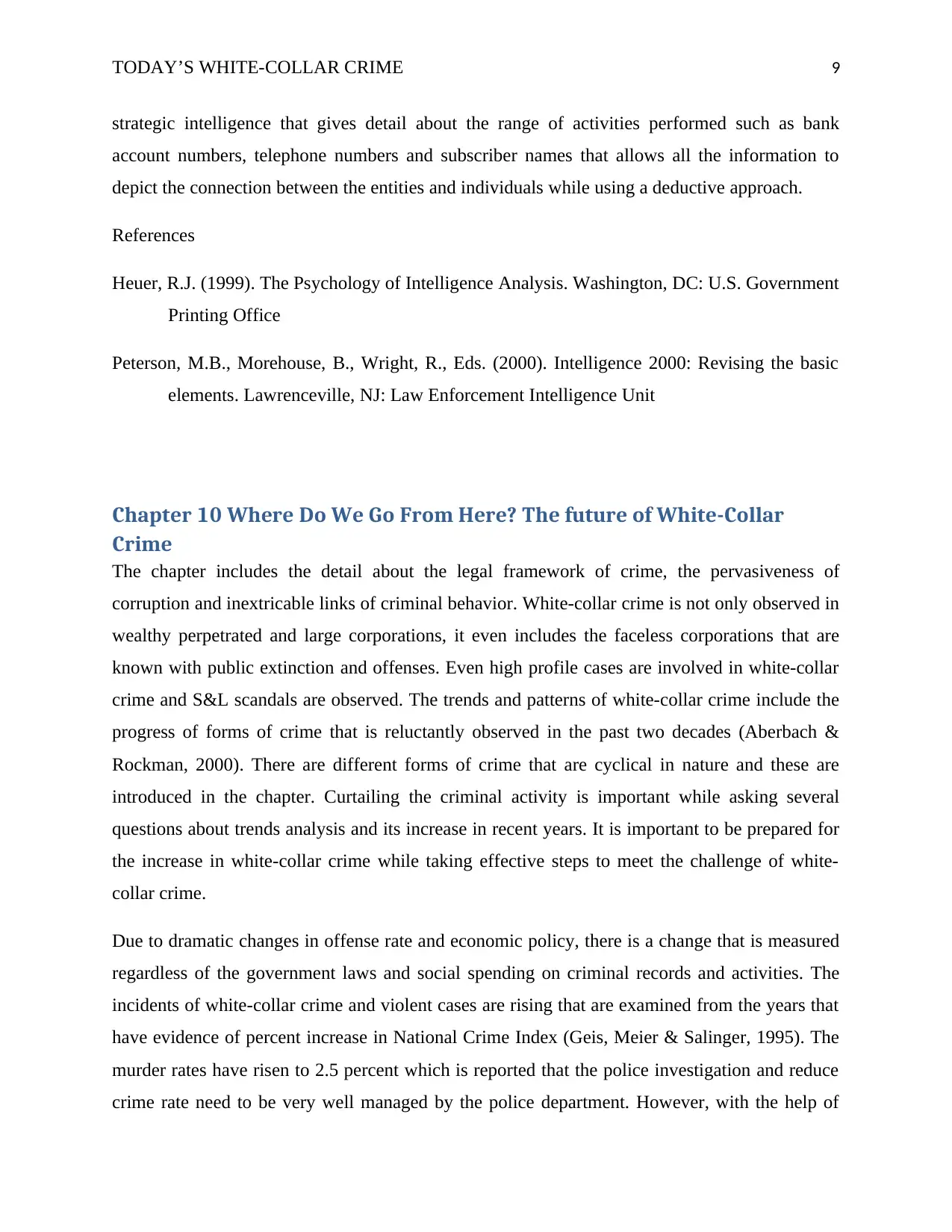
TODAY’S WHITE-COLLAR CRIME 9
strategic intelligence that gives detail about the range of activities performed such as bank
account numbers, telephone numbers and subscriber names that allows all the information to
depict the connection between the entities and individuals while using a deductive approach.
References
Heuer, R.J. (1999). The Psychology of Intelligence Analysis. Washington, DC: U.S. Government
Printing Office
Peterson, M.B., Morehouse, B., Wright, R., Eds. (2000). Intelligence 2000: Revising the basic
elements. Lawrenceville, NJ: Law Enforcement Intelligence Unit
Chapter 10 Where Do We Go From Here? The future of White-Collar
Crime
The chapter includes the detail about the legal framework of crime, the pervasiveness of
corruption and inextricable links of criminal behavior. White-collar crime is not only observed in
wealthy perpetrated and large corporations, it even includes the faceless corporations that are
known with public extinction and offenses. Even high profile cases are involved in white-collar
crime and S&L scandals are observed. The trends and patterns of white-collar crime include the
progress of forms of crime that is reluctantly observed in the past two decades (Aberbach &
Rockman, 2000). There are different forms of crime that are cyclical in nature and these are
introduced in the chapter. Curtailing the criminal activity is important while asking several
questions about trends analysis and its increase in recent years. It is important to be prepared for
the increase in white-collar crime while taking effective steps to meet the challenge of white-
collar crime.
Due to dramatic changes in offense rate and economic policy, there is a change that is measured
regardless of the government laws and social spending on criminal records and activities. The
incidents of white-collar crime and violent cases are rising that are examined from the years that
have evidence of percent increase in National Crime Index (Geis, Meier & Salinger, 1995). The
murder rates have risen to 2.5 percent which is reported that the police investigation and reduce
crime rate need to be very well managed by the police department. However, with the help of
strategic intelligence that gives detail about the range of activities performed such as bank
account numbers, telephone numbers and subscriber names that allows all the information to
depict the connection between the entities and individuals while using a deductive approach.
References
Heuer, R.J. (1999). The Psychology of Intelligence Analysis. Washington, DC: U.S. Government
Printing Office
Peterson, M.B., Morehouse, B., Wright, R., Eds. (2000). Intelligence 2000: Revising the basic
elements. Lawrenceville, NJ: Law Enforcement Intelligence Unit
Chapter 10 Where Do We Go From Here? The future of White-Collar
Crime
The chapter includes the detail about the legal framework of crime, the pervasiveness of
corruption and inextricable links of criminal behavior. White-collar crime is not only observed in
wealthy perpetrated and large corporations, it even includes the faceless corporations that are
known with public extinction and offenses. Even high profile cases are involved in white-collar
crime and S&L scandals are observed. The trends and patterns of white-collar crime include the
progress of forms of crime that is reluctantly observed in the past two decades (Aberbach &
Rockman, 2000). There are different forms of crime that are cyclical in nature and these are
introduced in the chapter. Curtailing the criminal activity is important while asking several
questions about trends analysis and its increase in recent years. It is important to be prepared for
the increase in white-collar crime while taking effective steps to meet the challenge of white-
collar crime.
Due to dramatic changes in offense rate and economic policy, there is a change that is measured
regardless of the government laws and social spending on criminal records and activities. The
incidents of white-collar crime and violent cases are rising that are examined from the years that
have evidence of percent increase in National Crime Index (Geis, Meier & Salinger, 1995). The
murder rates have risen to 2.5 percent which is reported that the police investigation and reduce
crime rate need to be very well managed by the police department. However, with the help of
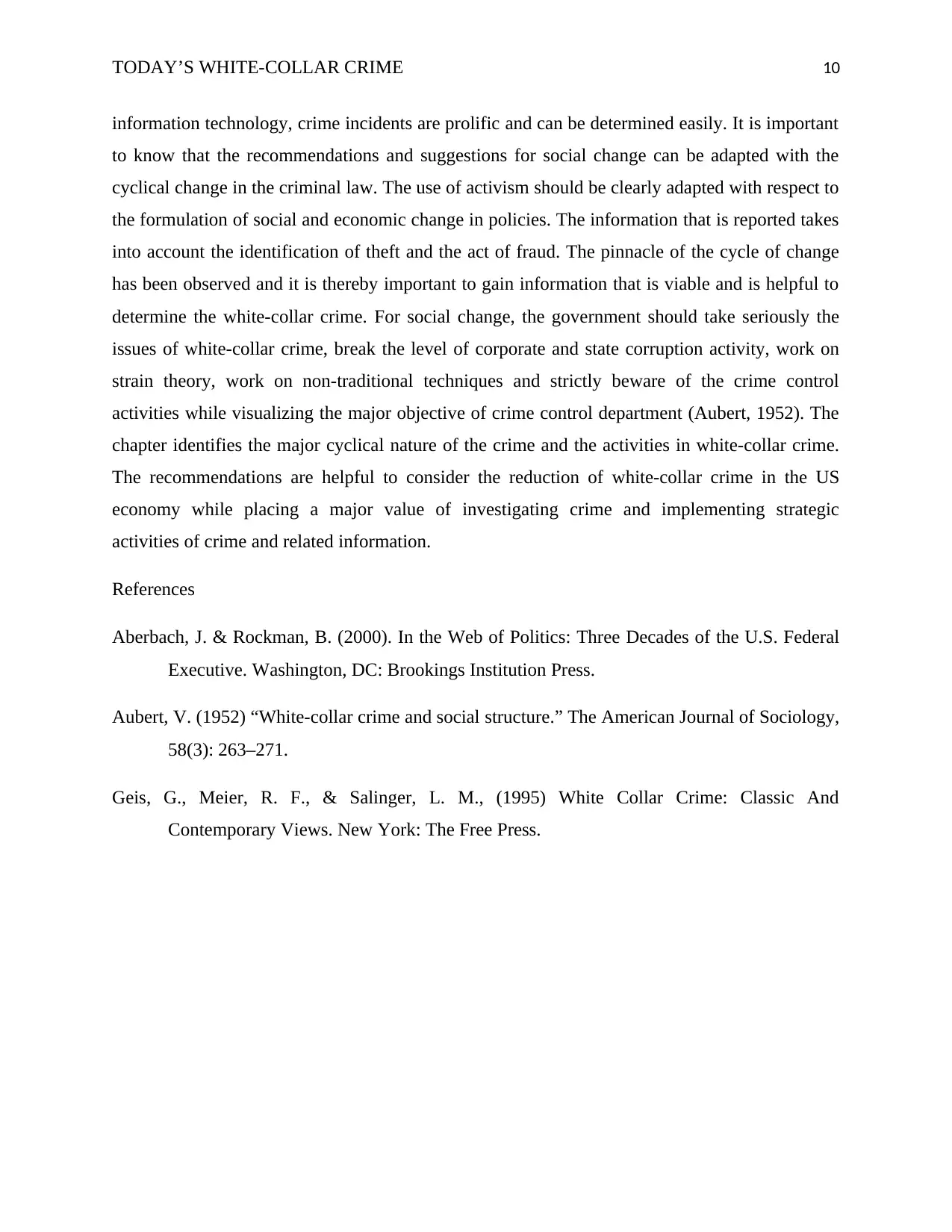
TODAY’S WHITE-COLLAR CRIME 10
information technology, crime incidents are prolific and can be determined easily. It is important
to know that the recommendations and suggestions for social change can be adapted with the
cyclical change in the criminal law. The use of activism should be clearly adapted with respect to
the formulation of social and economic change in policies. The information that is reported takes
into account the identification of theft and the act of fraud. The pinnacle of the cycle of change
has been observed and it is thereby important to gain information that is viable and is helpful to
determine the white-collar crime. For social change, the government should take seriously the
issues of white-collar crime, break the level of corporate and state corruption activity, work on
strain theory, work on non-traditional techniques and strictly beware of the crime control
activities while visualizing the major objective of crime control department (Aubert, 1952). The
chapter identifies the major cyclical nature of the crime and the activities in white-collar crime.
The recommendations are helpful to consider the reduction of white-collar crime in the US
economy while placing a major value of investigating crime and implementing strategic
activities of crime and related information.
References
Aberbach, J. & Rockman, B. (2000). In the Web of Politics: Three Decades of the U.S. Federal
Executive. Washington, DC: Brookings Institution Press.
Aubert, V. (1952) “White-collar crime and social structure.” The American Journal of Sociology,
58(3): 263–271.
Geis, G., Meier, R. F., & Salinger, L. M., (1995) White Collar Crime: Classic And
Contemporary Views. New York: The Free Press.
information technology, crime incidents are prolific and can be determined easily. It is important
to know that the recommendations and suggestions for social change can be adapted with the
cyclical change in the criminal law. The use of activism should be clearly adapted with respect to
the formulation of social and economic change in policies. The information that is reported takes
into account the identification of theft and the act of fraud. The pinnacle of the cycle of change
has been observed and it is thereby important to gain information that is viable and is helpful to
determine the white-collar crime. For social change, the government should take seriously the
issues of white-collar crime, break the level of corporate and state corruption activity, work on
strain theory, work on non-traditional techniques and strictly beware of the crime control
activities while visualizing the major objective of crime control department (Aubert, 1952). The
chapter identifies the major cyclical nature of the crime and the activities in white-collar crime.
The recommendations are helpful to consider the reduction of white-collar crime in the US
economy while placing a major value of investigating crime and implementing strategic
activities of crime and related information.
References
Aberbach, J. & Rockman, B. (2000). In the Web of Politics: Three Decades of the U.S. Federal
Executive. Washington, DC: Brookings Institution Press.
Aubert, V. (1952) “White-collar crime and social structure.” The American Journal of Sociology,
58(3): 263–271.
Geis, G., Meier, R. F., & Salinger, L. M., (1995) White Collar Crime: Classic And
Contemporary Views. New York: The Free Press.
1 out of 10
Your All-in-One AI-Powered Toolkit for Academic Success.
+13062052269
info@desklib.com
Available 24*7 on WhatsApp / Email
![[object Object]](/_next/static/media/star-bottom.7253800d.svg)
Unlock your academic potential
© 2024 | Zucol Services PVT LTD | All rights reserved.